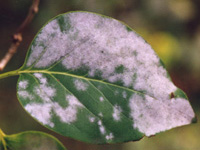
Exercise 4
POWDERY MILDEWS
Powdery mildews are obligate parasites. They are members of order Erysiphales and class Ascomycetes. They produce superficial mycelial growth on vascular plants and obtain their food by sending haustoria into tissues. This group of diseases is named as powdery mildews, because the fungi present in this group produce white chain conidia which give appearance of powdery mass at the infected places. Conidia of these fungi do not need moisture for germination. In powdery mildews, cleistothecia (lacking ostiole while having particular appendages) are produced late in the season.
Materials
Specimens of powdery mildew of rose (Sphaerothecapannosa), powdery mildew of cucurbits (Erysiphe cichoracearum) andpowdery mildew of shisham (Phyllactiniadelbergiae)
Procedure
- Draw the symptoms of diseased samples on your practical manual.
- Cut the cross section of infected leaf where white conidial growth is present, make its slide and observe the presence of conidia, conidiophores, asci, ascocarp, ascospores and haustoria in the tissues.
Questions
- Can powdery mildews be cultured on artificial medium?
- What are asci, and what kind of ascocarp is produced in powdery mildews?
Asci is the plural of ascus
Ascus is a sac like structure in which ascospores are produced
- How many ascospores are produced in asci?
8 ascospores


